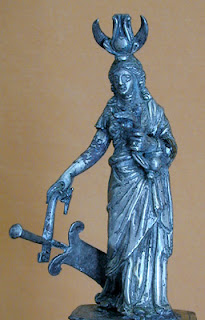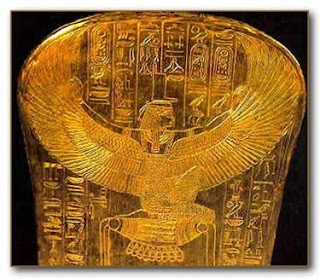
22. Another puzzling and discordant
element in the mythology is the goddess
Hathor. She is the most ubiquitous deity
of all. Yet she is seldom worshipped alone
and unmodified, and she is usually identified
with some other goddess or with a female
form of some god. Sekhet, Neit, lusaas, Best,
Uazit, Mut, Hekt, and Aset are all identified
with her at different places, and she
appears as female forms of Sopd, Behudt,
Anpu, and Tanen. She has no permanent
characteristics, no special attributes. The
uncouth human face with cow's ears and
modified cow's horns is the only typical form
of the goddess, and the cow and the sistrum
are her only emblems ; but these distinctions
are not constant. Worshipped in every
nome of Upper and Lower Egypt, she was
yet one of the most evasive deities, and most
easily modified and combined.
Let us reflect on what this indicates. That
the worship was thus general, equally diffused
over the country, points to the country having
been under a uniform condition of subjection
to her worshippers. While the fact that at
no centre is she solely worshipped, and at
very few places even prominently, points to
other deities having been already in possession
of the country when her devotees spread
her adoration. Where then are we to look
for her native land ? It has been shown that
Hathor was lady of Punt, and was thence
introduced into Egypt. And we may see
further confirmation of this. The only places
outside of Egypt with which she is connected
are Punt, Mafekt (Sinai) where the Punites
are very likely to have settled on the Red
Sea and Kapna. This last is usually
rendered as equal to the Gubla or Byblos,
but another Kapna was in the land of Punt,
and in the only place where Hathor is lady
of Kapna she is also lady of Wawat on the
Upper Nile. (Rec. II. 120.) Hence it is
more likely that the Kapna of Hathor is a
district of Punt. Further, of Isis, who is
identified at Dendera with Hathor, it is said,
"
Isis was born in the Iseum of Dendera of
Apt, the great one of the temple of Apt,
under the form of a woman black and red."
(M. Dend. text 30.) This points to a southern
origin. The Punites are coloured dark red,
and the neighbouring peoples black, while
the Asiatics are yellow, and the Libyans fair.
When we come to look to the nature of the
goddess we see further connection. That
Min was a Punite god is most likely, as his
position at Koptos on the Red Sea road
indicates, as well as his three colossal statues
there, apparently carved by a Red Sea people
in prehistoric time. And Min was the great
father-god. Hathor is the co-relative mothergod,
she in whom dwells the son Hor. Her
character as the universal mother is well
recognized, and is plainly on a par with the
idea of Min as the great father. Thus the
two gods whom we are led to connect with
the Punite race by their position, are similar
in nature and point to a worship of reproduction
apparently belonging to that people.
Another connection is seen in the position of
Hathor in the country. The only supreme
centre for her was at Dendera, which is
opposite to Koptos, the seat of Min, and
on the line of any invaders from the Red
Sea into the Nile valley.
That Hathor was brought in by a people
after the establishment of the other deities
we have already observed. And this exactly
agrees to her belonging to the Punite race
which founded the dynastic history. Their
great female divinity they identified with
every other goddess that they met throughout
Egypt, and established her worship also
as a local Hathor in every nome, calling her
the "
princess of the gods." The whole
phenomena of the diffusion of her worship
are thus accounted for by the historical
connection in which her origin leads us to
place her. Therefore, by her being stated
to come from Punt, by the foreign places to
which she is connected, by her colour, by
her being complementary to Min the other
Punite god, by the place of her main
sanctuary, and by the peculiar diffusion of
her worship, we are led to one conclusion
throughout that Hathor was the Punite
goddess introduced at the beginning of the
dynastic history



























